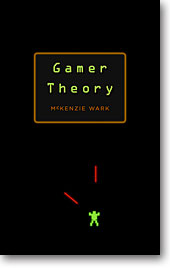Call for participation: Visualize This!
 How can we ‘see’ a written text? Do you have a new way of visualizing writing on the screen? If so, then McKenzie Wark and the Institute for the Future of the Book have a challenge for you. We want you to visualize McKenzie’s new book, Gamer Theory.
How can we ‘see’ a written text? Do you have a new way of visualizing writing on the screen? If so, then McKenzie Wark and the Institute for the Future of the Book have a challenge for you. We want you to visualize McKenzie’s new book, Gamer Theory.
Version 1 of Gamer Theory was presented by the Institute for the Future of the Book as a ‘networked book’, open to comments from readers. McKenzie used these comments to write version 2, which will be published in April by Harvard University Press. With the new version we want to extend this exploration of the book in the digital age, and we want you to be part of it.
All you have to do is register, download the v2 text, make a visualization of it (preferably of the whole text though you can also focus on a single part), and upload it to our server with a short explanation of how you did it.
All visualizations will be presented in a gallery on the new Gamer Theory site. Some contributions may be specially featured. All entries will receive a free copy of the printed book (until we run out).
By “visualization” we mean some graphical representation of the text that uses computation to discover new meanings and patterns and enables forms of reading that print can’t support. Some examples that have inspired us:
- Brad Paley’s Text Arc
- Marcos Weskamp’s Newsmap
- Fernanda Viegas’ Wikipedia “History Flow”
- Chirag Mehta’s US Presidential Speeches Tag Cloud
- Kushal Dave’s Exegesis
- Magnus Rembold and Jurgen Spath’s comparative essay visualizations in Total Interaction
- Philip DeCamp, Amber Frid-Jimenez, Jethran Guiness, Deb Roy: “Gist Icons” (pdf)
- CNET News.com’s The Big Picture
- Visuwords online graphical dictionary
- Christopher Collins’ DocuBurst
- Stamen Design’s rendering of Kate Hayles’ Narrating Bits in USC’s Vectors
- Brian Kim Stefans’ The Dreamlife of Letters
- Young-Hae Chang Heavy Industries
Understand that this is just a loose guideline. Feel encouraged to break the rules, hack the definition, show us something we hadn’t yet imagined.
All visualizations, like the web version of the text, will be Creative Commons licensed (Attribution-NonCommercial). You have the option of making your code available under this license as well or keeping it to yourself. We encourage you to share the source code of your visualization so that others can learn from your work and build on it. In this spirt, we’ve asked experienced hackers to provide code samples and resources to get you started (these will be made available on the upload page).
Gamer 2.0 will launch around April 18th in synch with the Harvard edition. Deadline for entries is Wednesday, April 11th.
Read GAM3R 7H30RY 1.1.
Download/upload page (registration required):
http://web.futureofthebook.org/gamertheory2.0/viz/
